www.skyandtelescope.org copy pastes.
Moderator: Community Team
Re: Astronomy
Joint venture between NASA, European Space Agency and the Canadian Space Agency.
In September 1962, Canada became the third country to put an artificial satellite into space.
In September 1962, Canada became the third country to put an artificial satellite into space.
-

 HitRed
HitRed
- Posts: 5026
- Joined: Fri Jun 26, 2015 12:16 pm




























Re: Astronomy
Cool video here captured on a telescope of the JWST.
https://www.space.com/james-webb-space-telescope-video-image-virtual-telescope-project
Skywatcher spots James Webb Space Telescope from Earth in telescope photos
By Chelsea Gohd published about 19 hours ago
Watch as the most powerful space telescope ever built drifts ever farther from Earth.
https://www.space.com/james-webb-space-telescope-video-image-virtual-telescope-project
JP4Fun


-

 jusplay4fun
jusplay4fun
- Posts: 7579
- Joined: Sun Jun 16, 2013 8:21 pm
- Location: Virginia






















Re: Astronomy
https://skyandtelescope.org/astronomy-news/this-weeks-sky-at-a-glance-december-31-january-8/
As the calendar flips the a new year, the night sky brims with bright stars, planets, and a meteor shower to help you celebrate.
FRIDAY, DECEMBER 31
■ For months Jupiter, Saturn, and Venus have highlighted the evening twilight in a diagonal line. But like 2021 itself, those times are ending. Jupiter is still high in the southwest, and dimmer Saturn is still two fists to its lower right. But Venus is dropping away fast, and Mercury is taking its place.
Look for Venus this evening very low above the west-southwest horizon, far lower right of Jupiter and Saturn as shown below. Left of Venus is newly-emerged Mercury. The next few days will see Venus drop from sight while Mercury climbs toward Saturn.
Four planets light the southwestern twilight now that Mercury is up in good view. But Venus will fast disappear.
JP4Fun


-

 jusplay4fun
jusplay4fun
- Posts: 7579
- Joined: Sun Jun 16, 2013 8:21 pm
- Location: Virginia






















Re: Astronomy
THIS WEEK'S PLANET ROUNDUP (Jan 7-15, 2022)
https://skyandtelescope.org/astronomy-news/this-weeks-sky-at-a-glance-january-7-15/
Mercury is low in the west-southwest in twilight, with Saturn near it. Watch their changing configuration, as shown above. Mercury is fading; this week it diminishes from magnitude –0.5 to +0.6.
Venus is out of sight. It goes through solar conjunction, passing 5° north of the Sun, on January 8th. Next week it will begin emerging low in the dawn.
Mars, in the feet of Ophiuchus, is low in the southeast in early dawn. It's far and faint at magnitude +1.5. To its right or upper right, Mars-colored Antares twinkles a little brighter at magnitude +1.0. Mars and Antares are nearly 10° apart on the morning of January 8th, widening to 13° by the 15th.
Mars is on the far side of its orbit from us, so in a telescope it's just a tiny shimmering blob 4 arcseconds wide.
Jupiter, magnitude –2.1 in Aquarius, shines brightly in the southwest at dusk. Spot Fomalhaut, magnitude +1.2, two fists at arm's length to Jupiter's lower left.
Saturn, magnitude +0.7 in Capricornus, is that same distance to Jupiter's lower right.
https://skyandtelescope.org/astronomy-news/this-weeks-sky-at-a-glance-january-7-15/
Mercury is low in the west-southwest in twilight, with Saturn near it. Watch their changing configuration, as shown above. Mercury is fading; this week it diminishes from magnitude –0.5 to +0.6.
Venus is out of sight. It goes through solar conjunction, passing 5° north of the Sun, on January 8th. Next week it will begin emerging low in the dawn.
Mars, in the feet of Ophiuchus, is low in the southeast in early dawn. It's far and faint at magnitude +1.5. To its right or upper right, Mars-colored Antares twinkles a little brighter at magnitude +1.0. Mars and Antares are nearly 10° apart on the morning of January 8th, widening to 13° by the 15th.
Mars is on the far side of its orbit from us, so in a telescope it's just a tiny shimmering blob 4 arcseconds wide.
Jupiter, magnitude –2.1 in Aquarius, shines brightly in the southwest at dusk. Spot Fomalhaut, magnitude +1.2, two fists at arm's length to Jupiter's lower left.
Saturn, magnitude +0.7 in Capricornus, is that same distance to Jupiter's lower right.
JP4Fun


-

 jusplay4fun
jusplay4fun
- Posts: 7579
- Joined: Sun Jun 16, 2013 8:21 pm
- Location: Virginia






















Re: Astronomy
https://www.esa.int/Science_Exploration ... _exoplanet
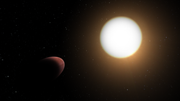
The European Space Agency wrote:ESA’s exoplanet mission Cheops has revealed that an exoplanet orbiting its host star within a day has a deformed shape more like that of a rugby ball than a sphere. This is the first time that the deformation of an exoplanet has been detected, offering new insights into the internal structure of these star-hugging planets.
The planet, known as WASP-103b is located in the constellation of Hercules. It has been deformed by the strong tidal forces between the planet and its host star WASP-103, which is about 200 degrees hotter and 1.7 times larger than the Sun.

-

 Maxleod
Maxleod
- Posts: 574
- Joined: Wed Nov 04, 2015 7:08 am
- Location: DARDIS (Drunkness And Relative Dimensions In Sleep)























Re: Astronomy
THIS WEEK'S SKY AT A GLANCE, JANUARY 14 – 22
https://skyandtelescope.org/astronomy-news/observing-news/this-weeks-sky-at-a-glance-january-14-22/
THIS WEEK'S PLANET ROUNDUP
Mercury and Saturn start the week very low in the west-southwest in twilight, far lower right of Jupiter as shown at the top of this page. Use binoculars. On the 14th they're only magnitudes +0.6 and +0.7, and in a day or two they're gone. (Although the farther south you are, the better.)
Venus (magnitude –4.3) emerges into dawn view. Look for it low in the east-southeast about 45 or 30 minutes before sunrise. It gets higher every day. In a telescope or good binoculars it's a thin crescent, as it was a few weeks ago in the evening sky. But now it's getting thicker every day, not thinner.
Mars, vastly fainter at magnitude +1.5, is low in the southeast in early dawn, some 15° or 20° to Venus's upper right (if Venus has even risen yet). Don't confuse Mars with brighter, Mars-colored Antares to its own upper right. Mars and Antares are 14° apart on the morning of January 15th, widening to 19° by the 22nd.
Mars is on the far side of its orbit from us, so in a telescope it's just a tiny blob 4 arcseconds wide.
Jupiter, magnitude –2.1 in Aquarius, still shines brightly in the southwest at dusk, lower every week.
https://skyandtelescope.org/astronomy-news/observing-news/this-weeks-sky-at-a-glance-january-14-22/
THIS WEEK'S PLANET ROUNDUP
Mercury and Saturn start the week very low in the west-southwest in twilight, far lower right of Jupiter as shown at the top of this page. Use binoculars. On the 14th they're only magnitudes +0.6 and +0.7, and in a day or two they're gone. (Although the farther south you are, the better.)
Venus (magnitude –4.3) emerges into dawn view. Look for it low in the east-southeast about 45 or 30 minutes before sunrise. It gets higher every day. In a telescope or good binoculars it's a thin crescent, as it was a few weeks ago in the evening sky. But now it's getting thicker every day, not thinner.
Mars, vastly fainter at magnitude +1.5, is low in the southeast in early dawn, some 15° or 20° to Venus's upper right (if Venus has even risen yet). Don't confuse Mars with brighter, Mars-colored Antares to its own upper right. Mars and Antares are 14° apart on the morning of January 15th, widening to 19° by the 22nd.
Mars is on the far side of its orbit from us, so in a telescope it's just a tiny blob 4 arcseconds wide.
Jupiter, magnitude –2.1 in Aquarius, still shines brightly in the southwest at dusk, lower every week.
JP4Fun


-

 jusplay4fun
jusplay4fun
- Posts: 7579
- Joined: Sun Jun 16, 2013 8:21 pm
- Location: Virginia






















Re: Astronomy
THIS WEEK'S SKY AT A GLANCE, FEBRUARY 4 – 12
The solar system has four terrestrial (rocky) planets: Mercury, Venus, Earth, and Mars. All four are visible at dawn this week, as shown below.
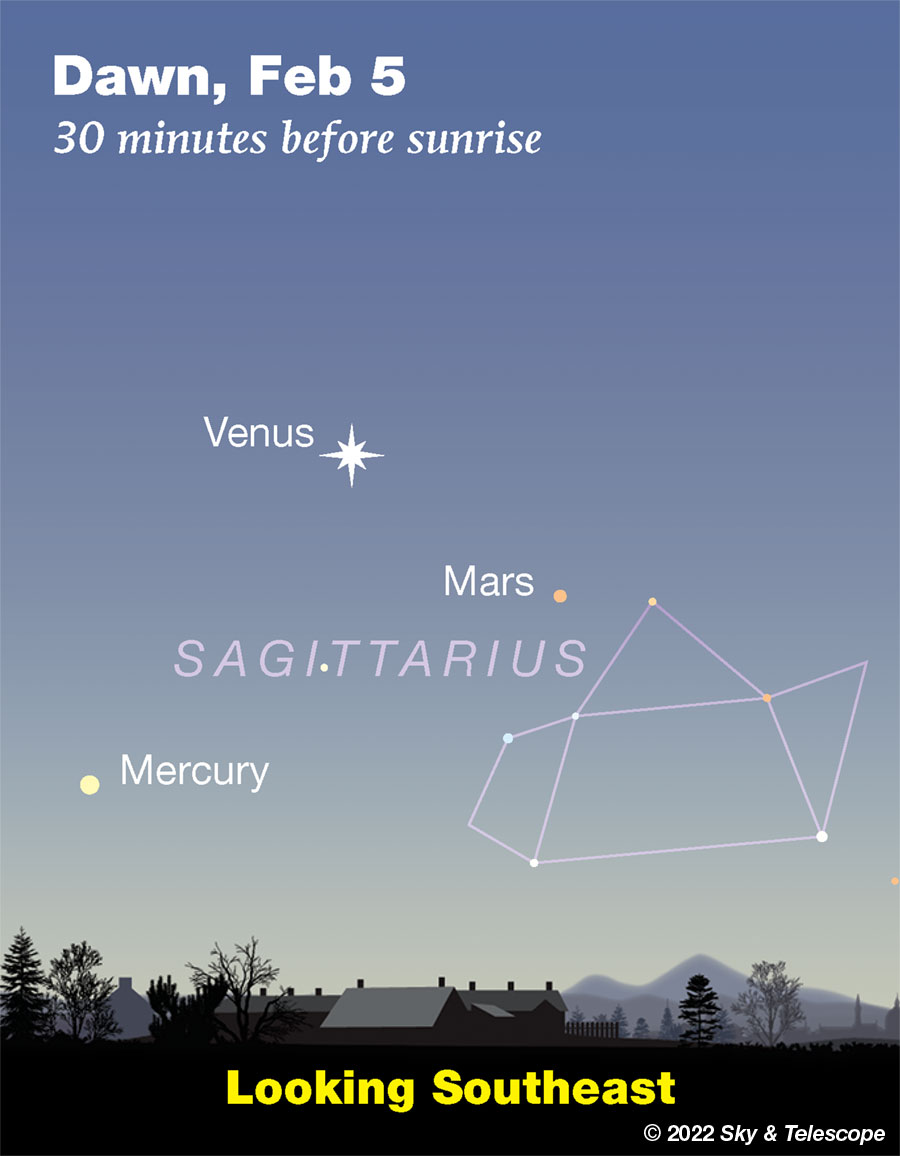

By now the morning planetary triangle has changed shape a little. Meanwhile the Sagittarius Teapot has risen into more direct view, though you'll still need binoculars for its stars in dawn's early light.
https://skyandtelescope.org/astronomy-news/observing-news/this-weeks-sky-at-a-glance-february-4-12/
JP4Fun


-

 jusplay4fun
jusplay4fun
- Posts: 7579
- Joined: Sun Jun 16, 2013 8:21 pm
- Location: Virginia






















Re: Astronomy
Things look the same here:
https://skyandtelescope.org/astronomy-news/observing-news/this-weeks-sky-at-a-glance-february-4-12/
Venus vastly outshines Mars this season, as always happens when the two are in the same part of the sky. Mercury also surpasses Mars now, once it gets above the thick horizon air.
https://skyandtelescope.org/astronomy-news/observing-news/this-weeks-sky-at-a-glance-february-4-12/
THIS WEEK'S PLANET ROUNDUP
Mercury, Venus, and Mars shine in early dawn. They're low in the southeast, forming a triangle that very gradually changes shape this week as shown above.
Brightest of course is Venus, now peaking at a dazzling magnitude –4.9. In a telescope it's a thick crescent; the globe appears about a quarter sunlit, as always when Venus is at its greatest brilliancy.
Mars is only one three-hundredth that bright, at a paltry magnitude +1.4. Look for it less than a fist to Venus's lower right.
Mercury is about twice that far to Venus's lower left. It brightens from magnitude +0.5 on February 5th to +0.1 on the 12th.
Jupiter (magnitude –2.0, in Aquarius) sinks lower in evening twilight every day. Look west-southwest. It sets around twilight's end.
JP4Fun


-

 jusplay4fun
jusplay4fun
- Posts: 7579
- Joined: Sun Jun 16, 2013 8:21 pm
- Location: Virginia






















Re: Astronomy
THIS WEEK'S SKY AT A GLANCE, FEBRUARY 11 – 19
BY: ALAN MACROBERT FEBRUARY 11, 2022
https://skyandtelescope.org/astronomy-news/observing-news/this-weeks-sky-at-a-glance-february-11-19/
BY: ALAN MACROBERT FEBRUARY 11, 2022
https://skyandtelescope.org/astronomy-news/observing-news/this-weeks-sky-at-a-glance-february-11-19/
THIS WEEK'S PLANET ROUNDUP
Mercury, Venus, and Mars continue to shine in early dawn, as shown above. They're low in the southeast, forming a triangle that changes shape slightly through the week.
Brightest is Venus, now peaking at a dazzling magnitude –4.9. In a telescope it's a thick crescent; the globe appears about a quarter sunlit, as it always does when Venus is at its greatest brilliancy.
Mars is only one three-hundredth that bright at a puny magnitude +1.4. Look for it 6° to Venus's lower right.
Mercury is more twice that far to Venus's lower left. It's about magnitude 0.0 all week.
JP4Fun


-

 jusplay4fun
jusplay4fun
- Posts: 7579
- Joined: Sun Jun 16, 2013 8:21 pm
- Location: Virginia






















Re: Astronomy
Interesting things this week: THIS WEEK'S SKY AT A GLANCE, MARCH 11 – 19
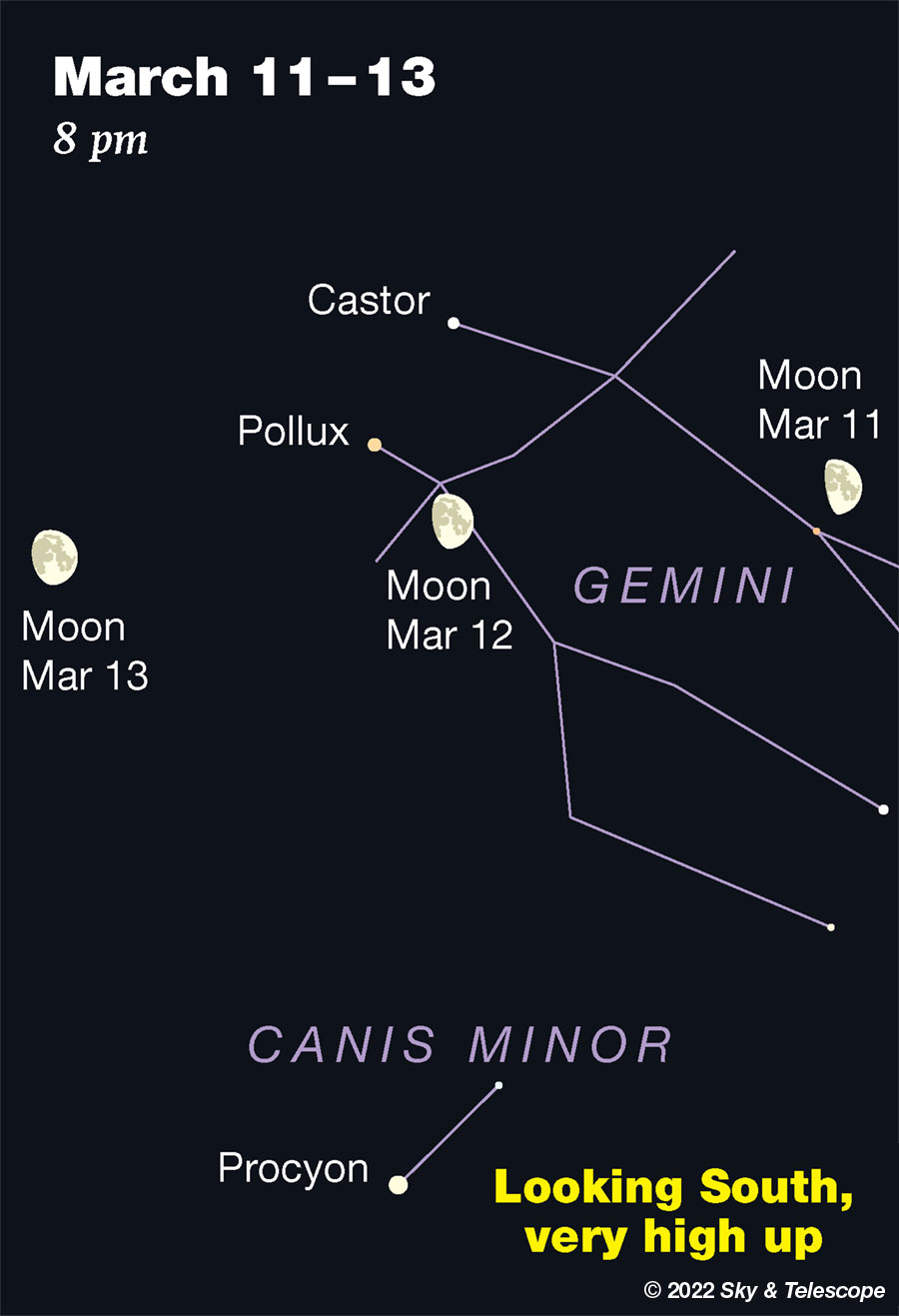
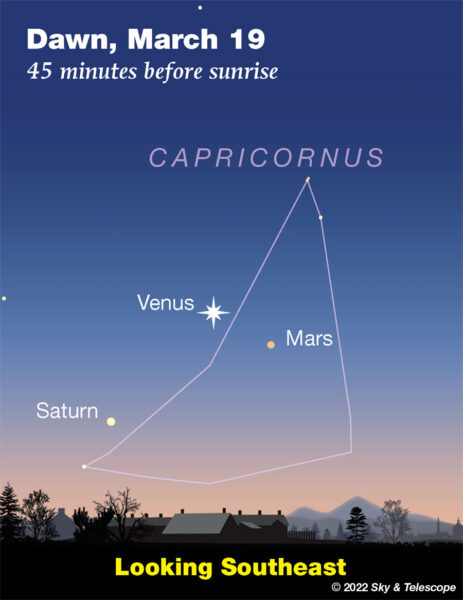
https://skyandtelescope.org/astronomy-news/observing-news/this-weeks-sky-at-a-glance-march-11-19-2/


WEDNESDAY, MARCH 16
■ Pollux and Castor in Gemini pass nearly overhead around 8 p.m. this week if you live in the world's mid-northern latitudes. They go smack overhead as seen from near latitude 30° north: Austin, Houston, and the US Gulf Coast, as well as northernmost Africa, Tibet, and Shanghai.
The "twin" heads of the Gemini figures are fraternal twins at best. Pollux is visibly brighter than Castor and pale orange. And as for their physical nature, they're not even the same species.
Pollux is a single orange giant. Castor is a binary pair of two much smaller, hotter, white main-sequence stars, a fine double in amateur telescopes. If Pollux were a basketball, Castor A and B would be a tennis ball and a baseball about a half mile apart.
Moreover, each Castor star is closely orbited by an unseen red dwarf — a marble in our scale model just a foot or so from each of the two bright primaries.
And a very distant tight pair of red dwarfs, Castor C, is visible in amateur scopes as a single, 10th-magnitude speck 70 arcseconds south-southeast of the main pair. In our scale model, they would be a pair of marbles about 3 inches apart at least 10 miles from Castor A and B. Space is big.
■ At nightfall, the Big Dipper is now as high in the northeast as Cassiopeia is in the northwest. The Dipper dominates on spring and summer evenings, and indeed the season is about to change: the spring equinox comes on March 20th.
Unaffected midway between the Dipper and Cas is, as always, Polaris.
THIS WEEK'S PLANET ROUNDUP
Mercury, Jupiter, and Neptune are out of sight in the glare of the Sun.
Venus, magnitude –4.6, is the bright "Morning Star" shining low in the southeast during dawn.
Mars, vastly fainter at magnitude +1.2, continues to hang 4° lower right of Venus all week. Look for it early before dawn gets too bright; Mars currently shines with a little less than 1% of Venus's light.
Challenge question! Why is Mars so much dimmer than Venus now? Four reasons combine to make it so, despite two other factors working in the opposite direction. Points for each of the six that you get! Answers at the bottom of this page.
Saturn, magnitude +0.8, is emerging into dawn view lower left of Venus as shown above. Bring binoculars. Their separation closes from 15° on the morning of March 12th to 9° on the 19th.
Saturn will pass 2° under Venus at their conjunction on the mornings of March 28th and 29th, with Mars still nearby.
Pollux is a single orange giant. Castor is a binary pair of two much smaller, hotter, white main-sequence stars, a fine double in amateur telescopes. If Pollux were a basketball, Castor A and B would be a tennis ball and a baseball about a half mile apart.
Moreover, each Castor star is closely orbited by an unseen red dwarf — a marble in our scale model just a foot or so from each of the two bright primaries.
And a very distant tight pair of red dwarfs, Castor C, is visible in amateur scopes as a single, 10th-magnitude speck 70 arcseconds south-southeast of the main pair. In our scale model, they would be a pair of marbles about 3 inches apart at least 10 miles from Castor A and B. Space is big.
■ At nightfall, the Big Dipper is now as high in the northeast as Cassiopeia is in the northwest. The Dipper dominates on spring and summer evenings, and indeed the season is about to change: the spring equinox comes on March 20th.
Unaffected midway between the Dipper and Cas is, as always, Polaris.
https://skyandtelescope.org/astronomy-news/observing-news/this-weeks-sky-at-a-glance-march-11-19-2/
JP4Fun


-

 jusplay4fun
jusplay4fun
- Posts: 7579
- Joined: Sun Jun 16, 2013 8:21 pm
- Location: Virginia






















Re: Astronomy
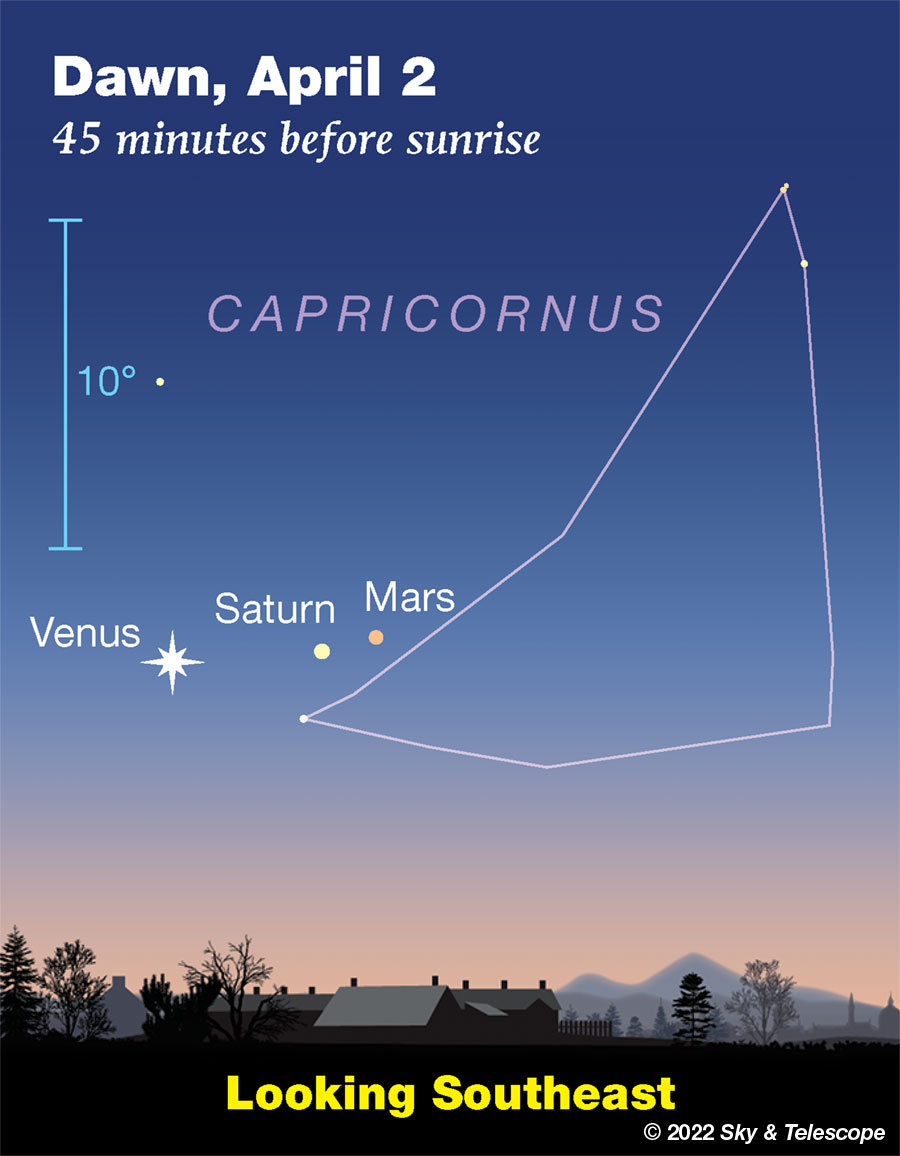
THIS WEEK'S PLANET ROUNDUP
Mercury, Jupiter, and Neptune remain out of sight in the glare of the Sun.
Venus, magnitude –4.4, is the bright "Morning Star" shining low in the southeast during dawn.
Mars, vastly fainter at magnitude +1.1, glimmers 5° to 7° to Venus's right.
Saturn, Marslike at magnitude +0.9, glows below Venus early in the week, and right of it by week's end.
These three planets form three different isosceles triangles (triangles with two equal sides) in the span of just a week: On the mornings of March 24th, 28th, and 31st.
In a telescope, Venus appears just about at dichotomy: half-lit. The March Sky & Telescope, page 50, discusses the non-obvious conundrum of Venus's slightly mistimed dichotomies, which puzzled astronomers starting in 1793. You'll have your crispest telescopic views of Venus when it's high in thinner air: in a blue daylight sky even long after sunrise.
Mars in a telescope is a hopeless little fuzzdot 5 arcseconds across. But expect a good Mars opposition next December — when it will be 17 arcseconds wide very high in the midnight sky, not far from overhead.
Saturn too is badly blurred by the poor seeing so low. But look forward to its opposition time in August and September. Saturn is entering the season in its 30-year "year" when massive white spots — gigantic, continent-size thunderhead clouds — sometimes well upward into view from the deeper, hidden atmospheric layers below. See Bob King's Will Saturn Sprout Spots This Observing Season?
https://skyandtelescope.org/uncategorized/this-weeks-sky-at-a-glance-march-25-april-2-2/
JP4Fun


-

 jusplay4fun
jusplay4fun
- Posts: 7579
- Joined: Sun Jun 16, 2013 8:21 pm
- Location: Virginia






















Re: Astronomy
THIS WEEK'S SKY AT A GLANCE, APRIL 15 – 23
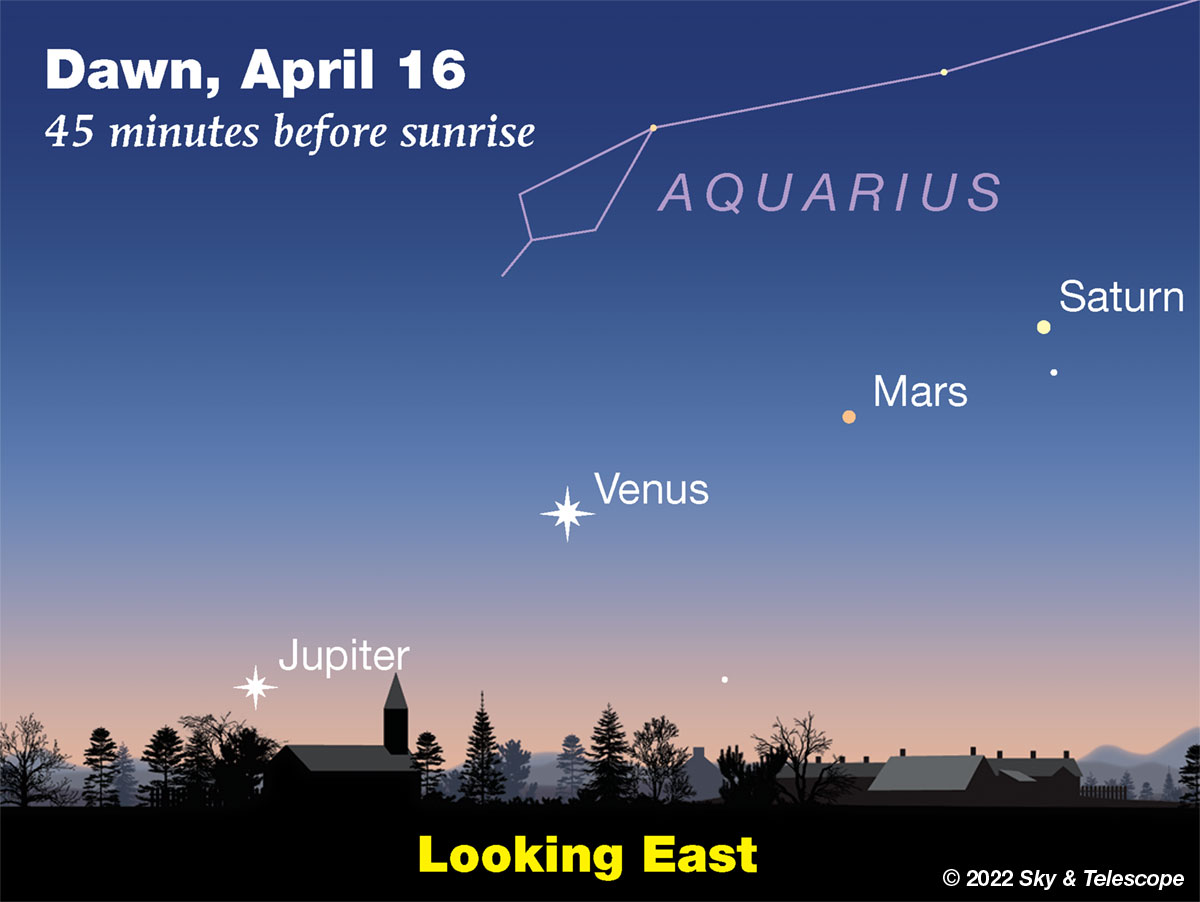
SATURDAY, APRIL 16
■ Full Moon (exactly full at 2:55 p.m. EDT). At nightfall, the Moon is in the dim feet of Virgo. Spica shines about 9° to its upper right (nearly a fist at arm's length), perhaps struggling to be seen through the moonlight. Brighter Arcturus is some 30° to the Moon's upper left.
SUNDAY, APRIL 17
■ Look west-southwest as the stars come out to catch Orion tilting down and away in his spring orientation, with his belt horizontal. The belt points left toward Sirius and right toward Aldebaran and, farther on, the Pleiades.
■ Look very high above Orion for Pollux and Castor, lined up roughly horizontally. They form the top of the huge Arch of Spring.
Lower left of Pollux and Castor, Procyon forms the Arch's left end. Look farther to the lower right from Pollux and Castor for 2nd-magnitude Menkalinan and then brilliant Capella, the Arch's right end. The Arch is part of the even larger Winter Hexagon, the rest of which is getting very low or setting.
THIS WEEK'S PLANET ROUNDUP
Mercury, after last week's conjunction with the Sun, creeps up into the low afterglow of sunset late this week. By about Thursday the 14th, look for it low above the west-northwest horizon 30 or 40 minutes after sunset. At least it's bright, magnitude –1.2 that evening. Binoculars will help, and with binoculars you may start to pick it up a few days earlier.
Venus, magnitude –4.4, is the bright "Morning Star" shining low in the southeast during dawn.
Mars and Saturn glimmer to Venus's upper right, in that order. They're vastly fainter: almost identical at magnitudes +1.1 and +0.9. Mars, however, is more orange than pale yellow Saturn. Each morning they're a little farther from Venus and from each other.
Jupiter emerges into dawn view this week, well to the lower left of Venus. On the morning of April 9th, it's 19° from Venus. By April 16th they close to within 13° of each other. Look for Jupiter about 45 to 30 minutes before sunrise.
https://skyandtelescope.org/astronomy-news/this-weeks-sky-at-a-glance-april-15-23-2/
JP4Fun


-

 jusplay4fun
jusplay4fun
- Posts: 7579
- Joined: Sun Jun 16, 2013 8:21 pm
- Location: Virginia






















Re: Astronomy
HitRed wrote:Joint venture between NASA, European Space Agency and the Canadian Space Agency.
In September 1962, Canada became the third country to put an artificial satellite into space.
Are you sure? I thought China already had satellites in space.
How many Chinese satellites are in space?
As of March 2020, there were 2,666 known satellites in orbit. Of these, 13.6 percent (363 satellites) are owned or operated by Chinese entities. This is more than twice the number of Russian satellites (169) in operation.
https://chinapower.csis.org/china-space-launch/
and please see; there is an interesting grapy there at this site:
https://dewesoft.com/daq/every-satellite-orbiting-earth-and-who-owns-them
https://dewesoft.com/upload/news/daq/satellites/every-satellite-orbiting-earth-who-owns-them-optimized.png
JP4Fun


-

 jusplay4fun
jusplay4fun
- Posts: 7579
- Joined: Sun Jun 16, 2013 8:21 pm
- Location: Virginia






















Re: Astronomy
https://www.theguardian.com/science/202 ... -spectacle
The BBC wrote:Jupiter and Venus, two of the solar system’s brightest planets, will appear to almost touch in a rare celestial spectacle this weekend.
Although in reality they will be millions of miles apart, for stargazers on Earth they will appear to be close enough to almost collide in a planetary conjunction that occurs once a year.
However, this year Jupiter and Venus will look much closer together than usual and should be visible with just a pair of binoculars or even the naked eye. If you miss it, you will have to wait another 17 years for a repeat performance.
-

 Maxleod
Maxleod
- Posts: 574
- Joined: Wed Nov 04, 2015 7:08 am
- Location: DARDIS (Drunkness And Relative Dimensions In Sleep)























Re: Astronomy
Maxleod wrote:https://www.theguardian.com/science/2022/apr/30/jupiter-and-venus-will-seem-to-nearly-collide-in-rare-celestial-spectacleThe BBC wrote:Jupiter and Venus, two of the solar system’s brightest planets, will appear to almost touch in a rare celestial spectacle this weekend.
Although in reality they will be millions of miles apart, for stargazers on Earth they will appear to be close enough to almost collide in a planetary conjunction that occurs once a year.
However, this year Jupiter and Venus will look much closer together than usual and should be visible with just a pair of binoculars or even the naked eye. If you miss it, you will have to wait another 17 years for a repeat performance.
Due to clouds, I saw the two planets CLOSE together a few days later. Sorry I missed it, but I did see the Jupiter-Saturn conjunction in Dec. 2021 (as I best recall).
JP4Fun


-

 jusplay4fun
jusplay4fun
- Posts: 7579
- Joined: Sun Jun 16, 2013 8:21 pm
- Location: Virginia






















Re: Astronomy
There are very cool images and videos on this topic at both Links. **
First image of black hole at the heart of Milky Way
https://news.harvard.edu/gazette/story/2022/05/second-black-hole-image-unveiled-first-from-our-galaxy/
https://www.nationalgeographic.com/science/article/black-holes
**And NO, a black hole is not a prostitute.
First image of black hole at the heart of Milky Way
An international team of astronomers led by scientists at the Center for Astrophysics | Harvard & Smithsonian who produced the first direct image of a black hole three years ago have now produced a portrait of a second, this time a much-anticipated glimpse of one at the heart of the Milky Way.
The new picture was captured by researchers from the Event Horizon Telescope (EHT) Collaboration who unveiled their first image in 2019. The group targeted both black holes at the outset but focused their attention on one at a time, owing to a difference in the complexity of the two projects.
“This is our supermassive black hole,” said Peter Galison, director of Harvard’s Black Hole Initiative, a member of the EHT team, and the Joseph Pellegrino University Professor in the History of Science and Physics. “This is at the center of where we live.”
The image of this object known as Sagittarius A-star, often referred to as Sgr A* (pronounced sadge-ay-star), shows the telltale sign of a black hole, as did the earlier one in the Messier 87 galaxy (M87): a bright ring of superhot glowing material circling a dark center so dense and bottomless that not even light can escape. The way the light bends around the dark center, known as the event horizon, shows the object’s powerful gravity, which is four million times that of our sun.
The new picture, described today in a special issue of The Astrophysical Journal Letters, provides the first direct visual evidence that the giant lurking 27,000 light-years away at the center of Earth’s galaxy is, in fact, a supermassive black hole. It also bolsters theories of where these cosmic monsters exist and may help to explain how galaxies are formed.
https://news.harvard.edu/gazette/story/2022/05/second-black-hole-image-unveiled-first-from-our-galaxy/
Black Holes, explained
These infinitely dense points in space will spaghettify anything that ventures too close.
Black holes are points in space that are so dense they create deep gravity sinks. Beyond a certain region, not even light can escape the powerful tug of a black hole's gravity. And anything that ventures too close—be it star, planet, or spacecraft—will be stretched and compressed like putty in a theoretical process aptly known as spaghettification.
There are four types of black holes: stellar, intermediate, supermassive, and miniature. The most commonly known way a black hole forms is by stellar death. As stars reach the ends of their lives, most will inflate, lose mass, and then cool to form white dwarfs. But the largest of these fiery bodies, those at least 10 to 20 times as massive as our own sun, are destined to become either super-dense neutron stars or so-called stellar-mass black holes.
https://www.nationalgeographic.com/science/article/black-holes
**And NO, a black hole is not a prostitute.
JP4Fun


-

 jusplay4fun
jusplay4fun
- Posts: 7579
- Joined: Sun Jun 16, 2013 8:21 pm
- Location: Virginia






















Re: Astronomy
Total lunar eclipse
People in the Americas, Europe and Africa will see the total lunar eclipse during the night of May 15-16, 2022. Plus, on this night, the moon is close: a supermoon.
Penumbral eclipse begins at 1:32 UTC on May 16 (9:32 p.m. EDT on May 15).
Partial eclipse begins at 2:27 UTC on May 16 (10:27 p.m. EDT on May 15).
Totality begins (moon engulfed in Earth’s shadow) at 3:29 UTC on May 16 (11:29 p.m. EDT on May 15).
https://earthsky.org/astronomy-essentials/total-lunar-eclipse-may16-2022/
JP4Fun


-

 jusplay4fun
jusplay4fun
- Posts: 7579
- Joined: Sun Jun 16, 2013 8:21 pm
- Location: Virginia






















Re: Astronomy
also:
https://earthsky.org/astronomy-essentials/visible-planets-tonight-mars-jupiter-venus-saturn-mercury/
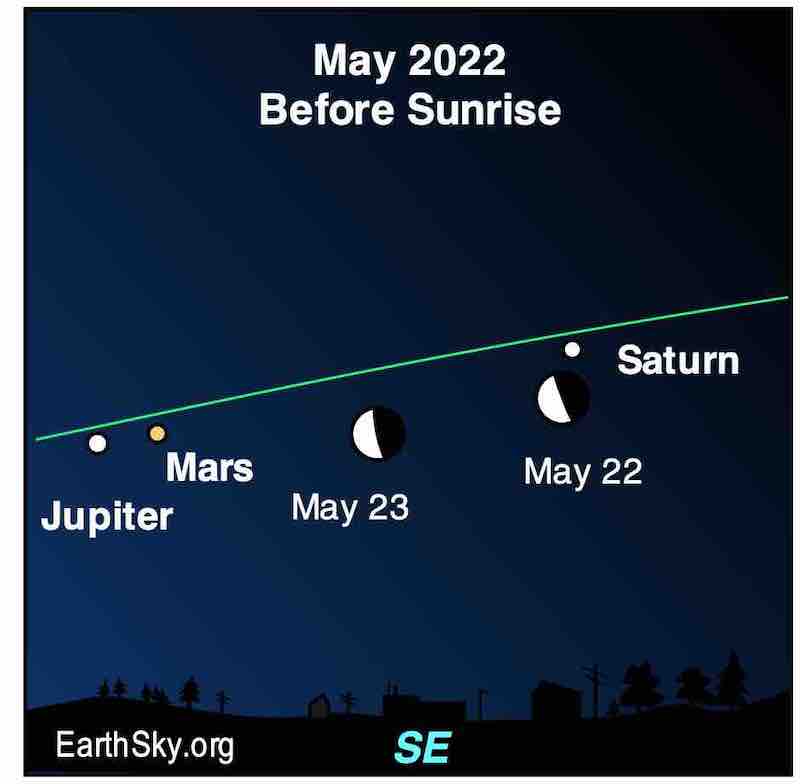
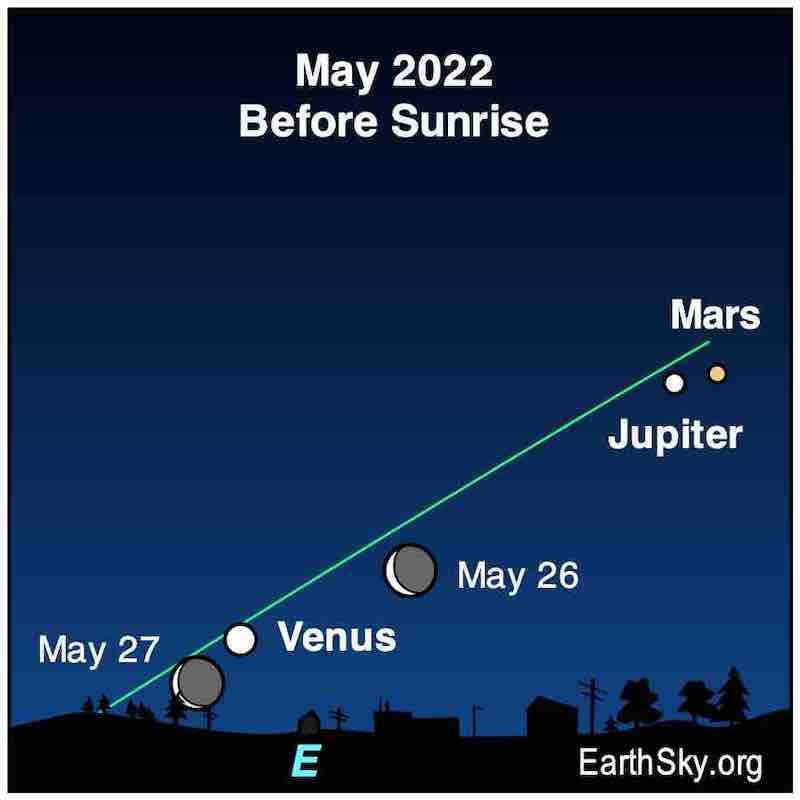
https://earthsky.org/astronomy-essentials/visible-planets-tonight-mars-jupiter-venus-saturn-mercury/


JP4Fun


-

 jusplay4fun
jusplay4fun
- Posts: 7579
- Joined: Sun Jun 16, 2013 8:21 pm
- Location: Virginia






















Re: Astronomy
THIS WEEK'S SKY AT A GLANCE, MAY 13 – 21
THIS WEEK'S PLANET ROUNDUP
Mercury is hidden in the glare of the Sun.
Venus and Jupiter, magnitudes –4.0 and –2.2 respectively, are the bright "Morning Stars" low in the east in early dawn. Venus is the lower one; Jupiter is increasingly far to Venus's upper right. They're separated by 13° on the morning of May 14th, widening to 20° by the 21st.
Mars, magnitude +o.8, is closer to the upper right of Jupiter. They're 9° apart on the morning of May 14th, closing to 5° on the 21st. Look early before the brightening dawn swallows it up.
Saturn, also magnitude +0.8, is a good 30° upper right of Mars.
https://skyandtelescope.org/astronomy-news/observing-news/this-weeks-sky-at-a-glance-may-13-20/
JP4Fun


-

 jusplay4fun
jusplay4fun
- Posts: 7579
- Joined: Sun Jun 16, 2013 8:21 pm
- Location: Virginia






















Re: Astronomy
You are right @ 2dimes. I am a fan of Hubble. I have always been fascinated with being able to reach out and see the things beyond what our normal vision allows. Microscopes and telescopes allow us to do just that. Terrestrial telescopes are burdened by our atmosphere. The Hubble telescope is Extraterrestrial and is not limited by having to peer through miles of atmosphere. It was named for Edwin Hubble a prominent US astronomer. While the telescope was completed in 1985, it was not launched into orbit until 1990. The delay was in no small part to the Challenger accident which occurred on Jan. 28th 1986.
The Hubble telescope is still active today, 27 years (and a handful of service missions). However, as most stories do, a sad end is in store for the Hubble. It's orbit is decaying, meaning it is slowly re-entering the earth's atmosphere. You can read a more detailed article . It will not survive the journey. In 2013, NASA projected that the telescope would remain functional until around 2020. It will burn up as early as 2028.
MOD EDIT by TeeGee
The Hubble telescope is still active today, 27 years (and a handful of service missions). However, as most stories do, a sad end is in store for the Hubble. It's orbit is decaying, meaning it is slowly re-entering the earth's atmosphere. You can read a more detailed article . It will not survive the journey. In 2013, NASA projected that the telescope would remain functional until around 2020. It will burn up as early as 2028.
MOD EDIT by TeeGee
-
 frede20
frede20
- Posts: 3
- Joined: Mon Jun 06, 2022 2:44 am
Re: Astronomy
frede20,
Perhaps I missed something, but your linked article only discussed telescopes to BUY for under $300 (USD), NOT about Hubble, HST.
https://theoptics.org/best-telescope-under-300/
Here is an article to discuss a successor to the Hubble Telescope, the James Webb Space Telescope:
https://webb.nasa.gov/content/about/comparisonWebbVsHubble.html
MORE:
also:

more information; another source:
and:
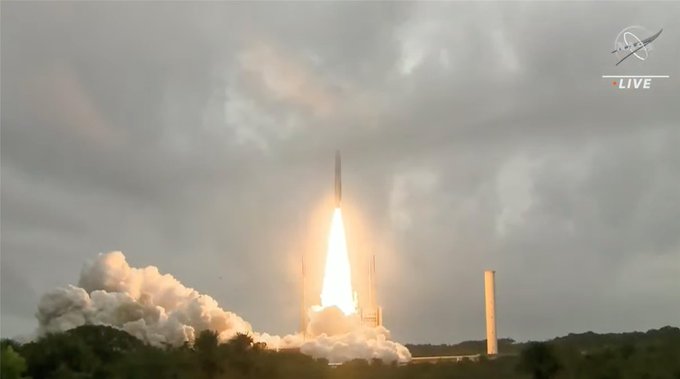
https://earthsky.org/space/james-webb-telescope-hubble-successor-to-launch/
Perhaps I missed something, but your linked article only discussed telescopes to BUY for under $300 (USD), NOT about Hubble, HST.
https://theoptics.org/best-telescope-under-300/
Here is an article to discuss a successor to the Hubble Telescope, the James Webb Space Telescope:
https://webb.nasa.gov/content/about/comparisonWebbVsHubble.html
Overview
Webb often gets called the replacement for Hubble, but we prefer to call it a successor. After all, Webb is the scientific successor to Hubble; its science goals were motivated by results from Hubble. Hubble's science pushed us to look to longer wavelengths to "go beyond" what Hubble has already done. In particular, more distant objects are more highly redshifted, and their light is pushed from the UV and optical into the near-infrared. Thus observations of these distant objects (like the first galaxies formed in the Universe, for example) requires an infrared telescope.
MORE:
Orbit
The Earth is 150 million km from the Sun and the moon orbits the earth at a distance of approximately 384,500 km. The Hubble Space Telescope orbits around the Earth at an altitude of ~570 km above it. Webb will not actually orbit the Earth - instead it will sit at the Earth-Sun L2 Lagrange point, 1.5 million km away!
also:
Essentially, Hubble can see the equivalent of "toddler galaxies" and Webb Telescope will be able to see "baby galaxies". One reason Webb will be able to see the first galaxies is because it is an infrared telescope. The universe (and thus the galaxies in it) is expanding. When we talk about the most distant objects, Einstein's General Relativity actually comes into play. It tells us that the expansion of the universe means it is the space between objects that actually stretches, causing objects (galaxies) to move away from each other. Furthermore, any light in that space will also stretch, shifting that light's wavelength to longer wavelengths. This can make distant objects very dim (or invisible) at visible wavelengths of light, because that light reaches us as infrared light. Infrared telescopes, like Webb, are ideal for observing these early galaxies.

more information; another source:
Webb Telescope launch December 25: Success!
UPDATE DECEMBER 25, 2021: The James Webb Space Telescope launched successfully via an Ariane 5 rocket this morning at 7:20 EST (12:20 UTC).
and:
Hubble’s successor
The Webb Telescope is the long-awaited successor to the Hubble Space Telescope. The $9.7-billion space telescope has been under development for decades. It has undergone many delays over its long history.

https://earthsky.org/space/james-webb-telescope-hubble-successor-to-launch/
JP4Fun


-

 jusplay4fun
jusplay4fun
- Posts: 7579
- Joined: Sun Jun 16, 2013 8:21 pm
- Location: Virginia






















Re: Astronomy
I believe he's a spambot. lol
00:33:53 ‹riskllama› will her and i ever hook up, LLT???
00:34:09 ‹LiveLoveTeach› You and Shannon?
00:34:20 ‹LiveLoveTeach› Bahahahahahaha
00:34:22 ‹LiveLoveTeach› I doubt it
00:34:30 ‹LiveLoveTeach› I don't think she's into farm animals
00:34:09 ‹LiveLoveTeach› You and Shannon?
00:34:20 ‹LiveLoveTeach› Bahahahahahaha
00:34:22 ‹LiveLoveTeach› I doubt it
00:34:30 ‹LiveLoveTeach› I don't think she's into farm animals
-

 Shannon Apple
Shannon Apple
- Chatter

- Posts: 2181
- Joined: Wed Jan 14, 2009 8:40 pm
- Location: Ireland





























Re: Astronomy
frede20 wrote:You are right @ 2dimes. I am a fan of Hubble. I have always been fascinated with being able to reach out and see the things beyond what our normal vision allows. Microscopes and telescopes allow us to do just that. Terrestrial telescopes are burdened by our atmosphere. The Hubble telescope is Extraterrestrial and is not limited by having to peer through miles of atmosphere. It was named for Edwin Hubble a prominent US astronomer. While the telescope was completed in 1985, it was not launched into orbit until 1990. The delay was in no small part to the Challenger accident which occurred on Jan. 28th 1986.
The Hubble telescope is still active today, 27 years (and a handful of service missions). However, as most stories do, a sad end is in store for the Hubble. It's orbit is decaying, meaning it is slowly re-entering the earth's atmosphere. You can read a more detailed article here. It will not survive the journey. In 2013, NASA projected that the telescope would remain functional until around 2020. It will burn up as early as 2028.
I thought it ODD the "he" would discuss Hubble, something we have NOT discussed, or it has been a LONG while. Any way, I had FUN learning more about JWST.
BTW: I saw a more obvious spambot elsewhere in this Forum in the past day or so.
JP4Fun


-

 jusplay4fun
jusplay4fun
- Posts: 7579
- Joined: Sun Jun 16, 2013 8:21 pm
- Location: Virginia






















Re: Astronomy
$6000 Home rooftop telescope VS $16 billion Hubble telescope

It's amazing how good home telescopes have gotten over the last 20 years.

It's amazing how good home telescopes have gotten over the last 20 years.
Dukasaur wrote: That was the night I broke into St. Mike's Cathedral and shat on the Archibishop's desk
-

 mookiemcgee
mookiemcgee
- Posts: 5536
- Joined: Wed Jul 03, 2013 2:33 pm
- Location: Northern CA































Re: Astronomy
We need an update
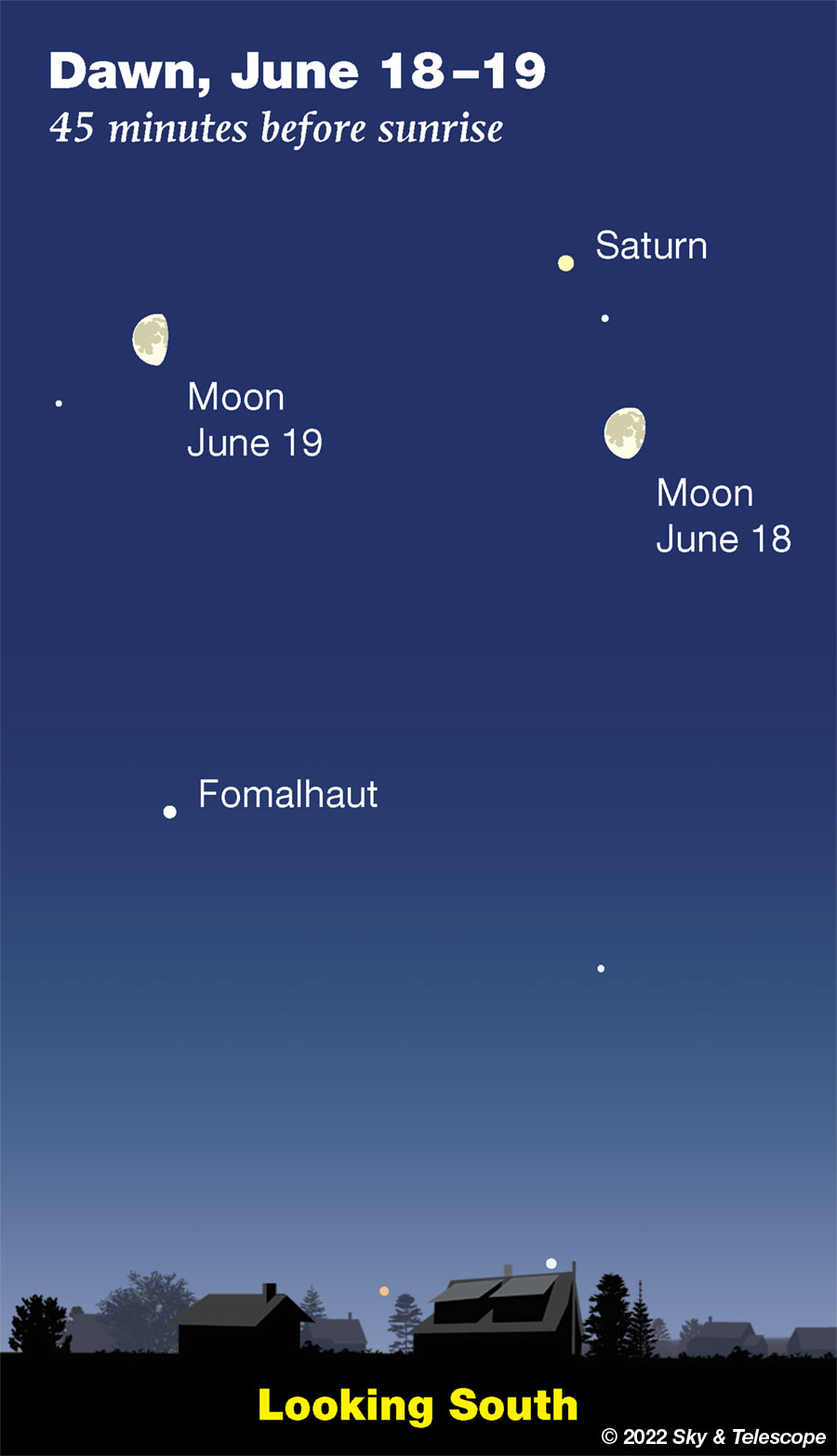
https://skyandtelescope.org/astronomy-news/observing-news/this-weeks-sky-at-a-glance-june-10-18-2/
THURSDAY, JUNE 16
■ Here it is five days to summer. But as twilight fades, look very low in the north-northwest for wintry Capella very out of season. Bring binoculars. The farther south you are the lower it will be, and if you're in the southern US, forget it; Capella season is over. But if you're as far north as Montreal or either of the Portlands (Oregon or Maine), Capella is actually circumpolar.
FRIDAY, JUNE 17
■ The waning gibbous Moon rises around midnight with Saturn glowing steadily about 7° to its left. Saturn is magnitude +0.7. Partway between it and the Moon look for Delta Capricorni, magnitude +2.8.
By the beginning of dawn Saturday morning this array is high in the south, now aligned more upright.
SATURDAY, JUNE 18
■ The Big Dipper hangs down by its handle high in the northwest. Spot the star at the end of its handle, the highest one. That's Alkaid, the tail of Ursa Major.

https://skyandtelescope.org/astronomy-news/observing-news/this-weeks-sky-at-a-glance-june-10-18-2/
JP4Fun


-

 jusplay4fun
jusplay4fun
- Posts: 7579
- Joined: Sun Jun 16, 2013 8:21 pm
- Location: Virginia






















Who is online
Users browsing this forum: No registered users


